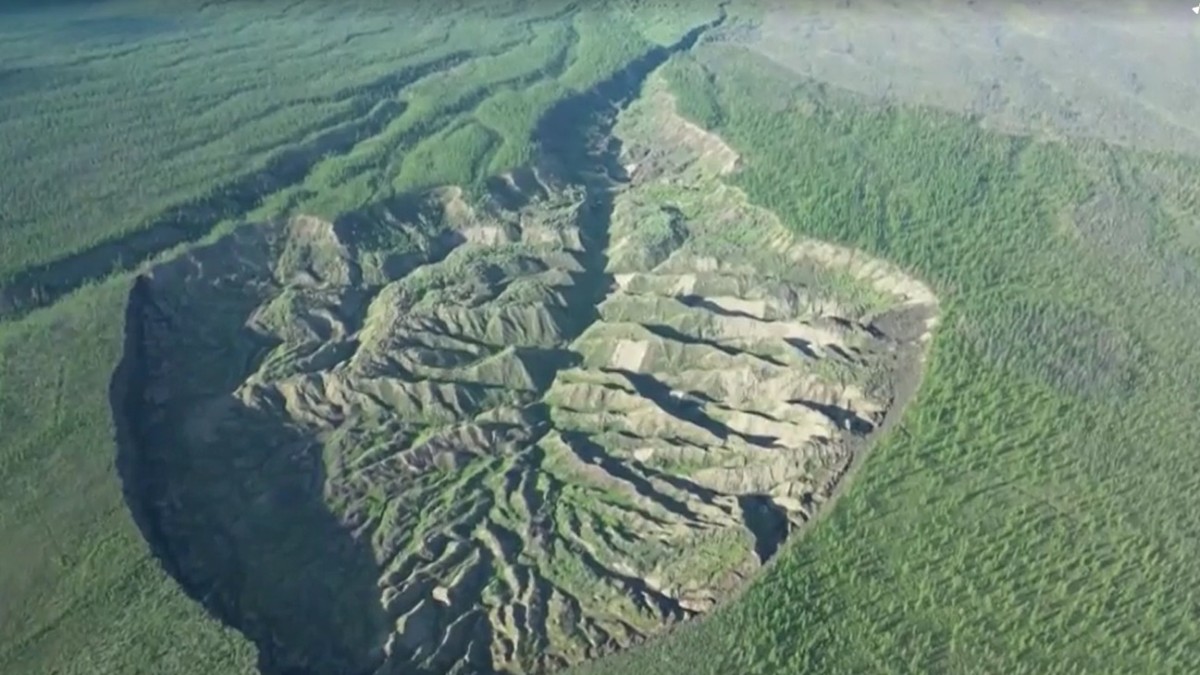Siberia is home to a giant hole, ominously called the “Gateway to Hell.”
The deep hole, however, has alarmed scientists as it is growing at a frightening rate.
This enormous crater is a warning of the dangerous repercussions of climate change as it gets deeper and larger.
Here’s all we know about it.
The Gateway to Hell
The 200-acre wide and 300-foot deep hole is located in the freezing Yana highlands of Siberia.
Also called the “Batagaika Crater,” it is the shape of a stingray, a horseshoe crab, or a giant tadpole, as per NDTV.
The hole, which is officially known as Batagay, is the second-oldest permafrost on Earth.
It began as a tiny slit when the land at the time had frozen completely during the Quaternary Ice Age, some 2.58 million years ago, according to Wion News.
Then, in declassified satellite photos from the 1960s, it was hardly discernible.
Notably, the Batagaika crater is actually a “restrogressive thaw megaslimp,” or a pit that occurs when permafrost thaws and causes a sizable landslide that expands as the ground’s edges fall backwards into the landslide, according to media reports.
When the people initially spotted Batagay in Yakutia, Russia, they reported hearing horrific noises coming from it, such as loud booms or “screams.”
Later, according to Wion, the clearing of the forest in the 1960s allowed sunshine to enter the hole and begin to warm the ground below.
It’s expanding
Impact Shorts
More ShortsThe deep hole has been observed to be expanding sooner than anticipated.
This is because of climate change.
It has grown so big that it is visible from space.
At this point, specialists are swarming the deep hole to acquire as much information as possible.
Washington University geophysicist Roger Michaelides views the crater as an exceptional opportunity to study permafrost, which is often submerged beneath the Earth’s surface, according to Moneycontrol.
He told Business Insider, “You’re talking mostly about frozen dirt underground, which by definition you often can’t see unless it’s been exposed somehow, like in this mega slump.”
“I think there is a lot we can learn from Batagaika, not only in terms of understanding how Batagaika will evolve with time, but also how similar features might develop and evolve over the Arctic,” he added.
“Even if they’re a tenth or a hundredth the size of Batagaika, the physics is fundamentally the same,” Michaelides further said.
It is also melting
Separately, a study published earlier this year found that the crater is growing deeper because permafrost melt has almost reached the bedrock at the bottom.
“The volume of the bowl-shaped retrogressive thaw slump (RTS) increases by approximately one million cubic metres per year,” glaciologist Alexander Kizyakoc wrote in the study, according to the New York Post.
Future threats
The adjacent Batagay River will have problems as a result of the fast melting.
Scientists warned that it will worsen riverbank erosion and have an impact on the surrounding ecosystem.
The crater’s fast expansion also raises the possibility of increased greenhouse gas emissions, the researchers added.
This is because thawed organic carbon is released into the atmosphere, according to NewsX.
They estimate that 4,000 to 5,000 tonnes of previously permafrost-locked organic carbon is currently released annually.
The number is likely to increase each year.
Some scientists have also warned that this gateway can engulf most of the land and prove dangerous for nearby villages once more areas start to melt, as per NDTV.
Nikita Tananaev, a researcher at Melnikov Permafrost Institute in Yaitsk, who was not part of the study, said that the nearby ecosystems are altering permanently because of leakage from the crater.
“This will lead to significant alterations to the riverine habitat, and the effect of sediment escaping the slump (the Batagaika crater) is even seen in the Yana River, the major river in the vicinity,” the report quoted him.
With inputs from agencies


)

)
)
)
)
)
)
)
)



